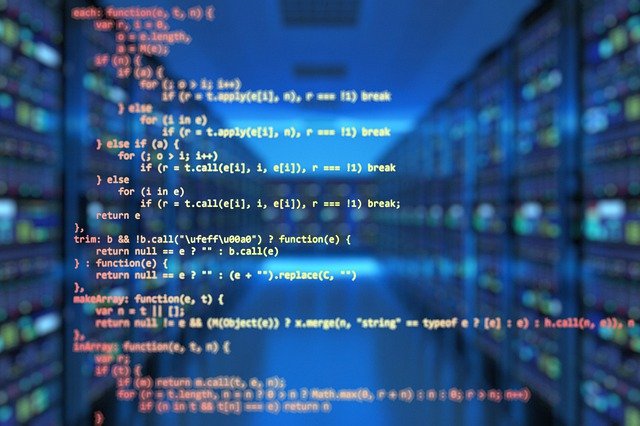
Algebra 2 by Richard Wright
Are you not my student and
has this helped you?
Objectives:
SDA NAD Content Standards (2018): AII.4.1, AII.6.1

Computer programming often use matrices called arrays. If a programmer needs to undo a matrix multiplication operation, then there is a problem because there is no matrix division! Instead the programmer would have to use an inverse matrix.
Matrices can be used to solve linear systems in a way that is different from Cramer's Rule. Before doing that; however, inverse matrices must be introduced.
Inverse matrices use the identity matrix. The identity matrix is a square matrix whose downward diagonals are 1's and the rest of the elements are 0's. It can be any sized square matrix. Examples are
$$ \left[\begin{matrix}1&0\\0&1\\\end{matrix}\right]\ \text{ and } \left[\begin{matrix}1&0&0\\0&1&0\\0&0&1\\\end{matrix}\right] $$
The identity matrix multiplied with any matrix of the same dimension equals the original matrix. That means the identity matrix is the matrix equivalent of 1.
A ∙ I = I ∙ A = A
Division by a matrix is not defined. You cannot divide by a matrix! So, multiply by the inverse of a matrix instead. Any matrix times its inverse matrix equals the identity matrix.
A · A−1 = [1] = I
This is similar to how a function times its inverse also equals 1 like \(x\left(x^{-1}\right)\ = x\left(\frac{1}{x}\right) = 1\). This is called the identity property.
The rule for the inverse of a 2×2 matrix is
If \(A=\left[\begin{matrix}a&b\\c&d\\\end{matrix}\right]\), then \(A^{-1}=\frac{1}{\left|\begin{matrix}a&b\\c&d\\\end{matrix}\right|}\left[\begin{matrix}d&-b\\-c&a\\\end{matrix}\right]\)
Notice that the elements in the downward diagonal switched places and the upward diagonal changed signs.
Find the inverse of \(\left[\begin{matrix}2&1\\-3&0\\\end{matrix}\right]\).
Solution
Fill in the formula.
$$ A^{-1}=\frac{1}{\left|\begin{matrix}a&b\\c&d\\\end{matrix}\right|}\left[\begin{matrix}d&-b\\-c&a\\\end{matrix}\right] $$
$$ A^{-1}=\frac{1}{\left|\begin{matrix}2&1\\-3&0\\\end{matrix}\right|}\left[\begin{matrix}0&-1\\3&2\\\end{matrix}\right] $$
Simplify the determinant part.
$$ =\frac{1}{2\left(0\right)-\left(-3\right)\left(1\right)}\left[\begin{matrix}0&-1\\3&2\\\end{matrix}\right] $$
$$ =\frac{1}{3}\left[\begin{matrix}0&-1\\3&2\\\end{matrix}\right] $$
Distribute the \(\frac{1}{3}\) to the matrix.
$$ =\left[\begin{matrix}0&-\frac{1}{3}\\1&\frac{2}{3}\\\end{matrix}\right] $$
Find the inverse of \(\left[\begin{matrix}3&-2\\4&5\\\end{matrix}\right]\).
Solution
Fill in the formula.
$$ A^{-1}=\frac{1}{\left|\begin{matrix}a&b\\c&d\\\end{matrix}\right|}\left[\begin{matrix}d&-b\\-c&a\\\end{matrix}\right] $$
$$ A^{-1}=\frac{1}{\left|\begin{matrix}3&-2\\4&5\\\end{matrix}\right|}\left[\begin{matrix}5&2\\-4&3\\\end{matrix}\right] $$
Simplify the determinant part.
$$ =\frac{1}{3\left(5\right)-4\left(-2\right)}\left[\begin{matrix}5&2\\-4&3\\\end{matrix}\right] $$
$$ =\frac{1}{23}\left[\begin{matrix}5&2\\-4&3\\\end{matrix}\right] $$
Distribute the \(\frac{1}{23}\) to the matrix.
$$ =\left[\begin{matrix}\frac{5}{23}&\frac{2}{23}\\-\frac{4}{23}&\frac{3}{23}\\\end{matrix}\right] $$
You can verify that two matrices are inverses by multiplying them together. The product should be the identity matrix.
$$ \left[\begin{matrix}2&1\\-3&0\\\end{matrix}\right]\cdot\left[\begin{matrix}0&-\frac{1}{3}\\1&\frac{2}{3}\\\end{matrix}\right] $$
$$ =\left[\begin{matrix}2\left(0\right)+1\left(1\right)&2\left(-\frac{1}{3}\right)+1\left(\frac{2}{3}\right)\\-3\left(0\right)+0\left(1\right)&-3\left(-\frac{1}{3}\right)+0\left(\frac{2}{3}\right)\\\end{matrix}\right] $$
$$ =\left[\begin{matrix}1&0\\0&1\\\end{matrix}\right] $$
Inverse matrices can be used to solve a matrix equation. Multiplying by the inverse matrix is used where division would normally be used.
If A, B, and X are matrices, and A · X = B, then
Multiply both sides by the inverse of matrix A.
A−1 · A · X = A−1 · B
The product of a matrix and its inverse is the identity matrix, I.
I · X = A-1 · B
The product of the identity matrix and any other matrix is equal to the other matrix. And the matrix equation is solved.
X = A-1 · B
Solve the matrix equation \(\left[\begin{matrix}2&-1\\3&0\\\end{matrix}\right]X=\left[\begin{matrix}-1&0\\3&6\\\end{matrix}\right]\).
Solution
Start by finding the inverse of the first matrix \(\left[\begin{matrix}2&-1\\3&0\\\end{matrix}\right]\).
$$ A^{-1}=\frac{1}{\left|\begin{matrix}a&b\\c&d\\\end{matrix}\right|}\left[\begin{matrix}d&-b\\-c&a\\\end{matrix}\right] $$
$$ A^{-1}=\frac{1}{\left|\begin{matrix}2&-1\\3&0\\\end{matrix}\right|}\left[\begin{matrix}0&1\\-3&2\\\end{matrix}\right] $$
$$ =\frac{1}{2\left(0\right)-3\left(-1\right)}\left[\begin{matrix}0&1\\-3&2\\\end{matrix}\right] $$
$$ =\frac{1}{3}\left[\begin{matrix}0&1\\-3&2\\\end{matrix}\right]=\left[\begin{matrix}0&\frac{1}{3}\\-1&\frac{2}{3}\\\end{matrix}\right] $$
Multiply both sides by the inverse. Remember the order of matrix multiplication is important, so make sure the inverse goes in the same place on both sides of the equation.
A−1 A X = A−1 B
$$ \left[\begin{matrix}0&\frac{1}{3}\\-1&\frac{2}{3}\\\end{matrix}\right]\left[\begin{matrix}2&-1\\3&0\\\end{matrix}\right]X=\left[\begin{matrix}0&\frac{1}{3}\\-1&\frac{2}{3}\\\end{matrix}\right]\left[\begin{matrix}-1&0\\3&6\\\end{matrix}\right] $$
The A−1 A on the left cancels out. On the right, multiply the matrices.
$$ X=\left[\begin{matrix}0\left(-1\right)+\frac{1}{3}\left(3\right)&0\left(0\right)+\frac{1}{3}\left(6\right)\\-1\left(-1\right)+\frac{2}{3}\left(3\right)&-1\left(0\right)+\frac{2}{3}\left(6\right)\\\end{matrix}\right] $$
$$ X=\left[\begin{matrix}\mathbf{1}&\mathbf{2}\\\mathbf{3}&\mathbf{4}\\\end{matrix}\right] $$
Solving a system of linear equations is similar to solving a matrix equation.
To solve a system of linear equations using inverse matrices,
Use inverse matrices to solve \(\left\{ \begin{alignat}{3} x&+&3y&=&-5 \\ 2x&-&y&=&4 \end{alignat} \right.\).
Solution
Write the system as a matrix equation in the form [coefficient matrix] [variables] = [constants].
$$ \left[\begin{matrix}1&3\\2&-1\\\end{matrix}\right]\left[\begin{matrix}x\\y\\\end{matrix}\right]=\left[\begin{matrix}-5\\4\\\end{matrix}\right] $$
Find the inverse of the coefficient matrix.
$$ A^{-1}=\frac{1}{\left|\begin{matrix}a&b\\c&d\\\end{matrix}\right|}\left[\begin{matrix}d&-b\\-c&a\\\end{matrix}\right] $$
$$ \left[\begin{matrix}1&3\\2&-1\\\end{matrix}\right]^{-1}=\frac{1}{\left|\begin{matrix}1&3\\2&-1\\\end{matrix}\right|}\left[\begin{matrix}-1&-3\\-2&1\\\end{matrix}\right] $$
$$ =\frac{1}{1\left(-1\right)-2\left(3\right)}\left[\begin{matrix}-1&-3\\-2&1\\\end{matrix}\right] $$
$$ =\frac{1}{-7}\left[\begin{matrix}-1&-3\\-2&1\\\end{matrix}\right]=\left[\begin{matrix}\frac{1}{7}&\frac{3}{7}\\\frac{2}{7}&-\frac{1}{7}\\\end{matrix}\right] $$
Multiply the front of both sides by the inverse. Left side becomes \(\left[\begin{matrix}x\\y\\\end{matrix}\right]\), so just multiply the right side.
$$ \left[\begin{matrix}x\\y\\\end{matrix}\right]=\left[\begin{matrix}\frac{1}{7}&\frac{3}{7}\\\frac{2}{7}&-\frac{1}{7}\\\end{matrix}\right]\left[\begin{matrix}-5\\4\\\end{matrix}\right] $$
$$ \left[\begin{matrix}x\\y\\\end{matrix}\right]=\left[\begin{matrix}\frac{1}{7}\left(-5\right)+\frac{3}{7}\left(4\right)\\\frac{2}{7}\left(-5\right)+\left(-\frac{1}{7}\right)\left(4\right)\\\end{matrix}\right] $$
$$ \left[\begin{matrix}x\\y\\\end{matrix}\right]=\left[\begin{matrix}1\\-2\\\end{matrix}\right] $$
The solution is (1, −2).
Page 676 #1, 5, 9, 11, 13, 15, 17, 27, 29, 31, and Mixed Review = 15
Mixed Review